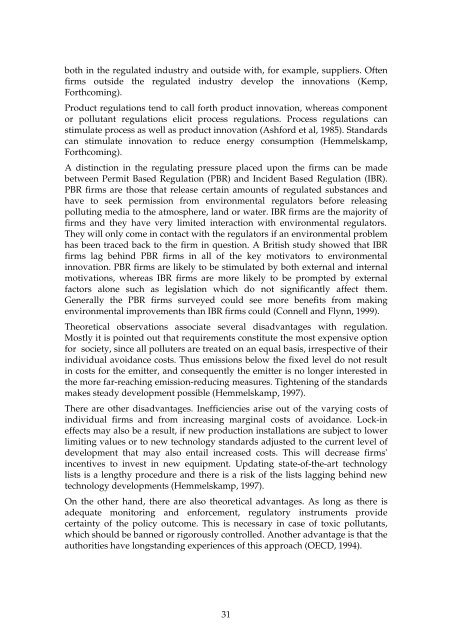Drivers of environmental innovation - Vinnova
Drivers of environmental innovation - Vinnova
Drivers of environmental innovation - Vinnova
Create successful ePaper yourself
Turn your PDF publications into a flip-book with our unique Google optimized e-Paper software.
oth in the regulated industry and outside with, for example, suppliers. Often<br />
firms outside the regulated industry develop the <strong>innovation</strong>s (Kemp,<br />
Forthcoming).<br />
Product regulations tend to call forth product <strong>innovation</strong>, whereas component<br />
or pollutant regulations elicit process regulations. Process regulations can<br />
stimulate process as well as product <strong>innovation</strong> (Ashford et al, 1985). Standards<br />
can stimulate <strong>innovation</strong> to reduce energy consumption (Hemmelskamp,<br />
Forthcoming).<br />
A distinction in the regulating pressure placed upon the firms can be made<br />
between Permit Based Regulation (PBR) and Incident Based Regulation (IBR).<br />
PBR firms are those that release certain amounts <strong>of</strong> regulated substances and<br />
have to seek permission from <strong>environmental</strong> regulators before releasing<br />
polluting media to the atmosphere, land or water. IBR firms are the majority <strong>of</strong><br />
firms and they have very limited interaction with <strong>environmental</strong> regulators.<br />
They will only come in contact with the regulators if an <strong>environmental</strong> problem<br />
has been traced back to the firm in question. A British study showed that IBR<br />
firms lag behind PBR firms in all <strong>of</strong> the key motivators to <strong>environmental</strong><br />
<strong>innovation</strong>. PBR firms are likely to be stimulated by both external and internal<br />
motivations, whereas IBR firms are more likely to be prompted by external<br />
factors alone such as legislation which do not significantly affect them.<br />
Generally the PBR firms surveyed could see more benefits from making<br />
<strong>environmental</strong> improvements than IBR firms could (Connell and Flynn, 1999).<br />
Theoretical observations associate several disadvantages with regulation.<br />
Mostly it is pointed out that requirements constitute the most expensive option<br />
for society, since all polluters are treated on an equal basis, irrespective <strong>of</strong> their<br />
individual avoidance costs. Thus emissions below the fixed level do not result<br />
in costs for the emitter, and consequently the emitter is no longer interested in<br />
the more far-reaching emission-reducing measures. Tightening <strong>of</strong> the standards<br />
makes steady development possible (Hemmelskamp, 1997).<br />
There are other disadvantages. Inefficiencies arise out <strong>of</strong> the varying costs <strong>of</strong><br />
individual firms and from increasing marginal costs <strong>of</strong> avoidance. Lock-in<br />
effects may also be a result, if new production installations are subject to lower<br />
limiting values or to new technology standards adjusted to the current level <strong>of</strong><br />
development that may also entail increased costs. This will decrease firms'<br />
incentives to invest in new equipment. Updating state-<strong>of</strong>-the-art technology<br />
lists is a lengthy procedure and there is a risk <strong>of</strong> the lists lagging behind new<br />
technology developments (Hemmelskamp, 1997).<br />
On the other hand, there are also theoretical advantages. As long as there is<br />
adequate monitoring and enforcement, regulatory instruments provide<br />
certainty <strong>of</strong> the policy outcome. This is necessary in case <strong>of</strong> toxic pollutants,<br />
which should be banned or rigorously controlled. Another advantage is that the<br />
authorities have longstanding experiences <strong>of</strong> this approach (OECD, 1994).<br />
31

















